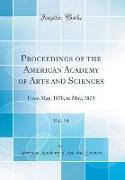- Start
- Proceedings of the American Academy of Arts and Sciences, Vol. 14
Proceedings of the American Academy of Arts and Sciences, Vol. 14
Angebote / Angebote:
Excerpt from Proceedings of the American Academy of Arts and Sciences, Vol. 14: From May, 1878, to May, 1879The young Flounder has already attained a considerable size, before any signs appear of the change in the position of the eye on the left side (see Pl. III. Figs. 3 - 5 and pi. IV. Fig. And before the young fish shows the least tendency to favor one side over the other. N ot until the young fish is fully three-eighths of an inch in length can the first slight difference be perceived in the position of the two eyes (when seen from above), the left eye being somewhat in advance of the other. In this species, the Flounder eventually lies down on the left side, which becomes colorless. In order to prevent repetitions, we shall call this the case of a right Flounder (dextral), that is, of a Flounder colorless on the left side, and where the left eye has passed over to the right side, calling the sides, at the same time, either blind or white, and the opposite ocular or colored.Plates III. And IV. Show very well the changes of form through which the young dextral Flounder passes before it finally assumes the appearance of the adult, and habitually rests with its colorless side upon the ground. All young F lounders, even long after they have all the characteristics of the adult, very frequently swim vertically for quite a length of time, or else swim near the surface, with the undulating movement they have when swimming over the bottom, their heads well raised, and bodies carried ¿at, parallel to the surface. Even quite old Flounders sometimes are caught swimming near the top of the water. Almost all the stages figured in Plates III. And IV. Were caught near the surface, swimming vertically, like any other young bony fishes but this they do only when they come up to feed, while the water is very smooth, about ten in the morning, on very bright sunny days, when they may be seen eagerly devouring swarms of embryo Crustaceans, of all orders. The young of other fishes seem to share this habit for of the latter I have examined no less than twenty-five species, caught at va rious times with a hand-net, swimming near the surface of the water, on bright sunny days, when not a ripple ruf¿ed the sea. With the least movement, all the more delicate of these embryos vanish, leav ing only the older and more vigorous, which in their turn disappear, and seek shelter in deeper water. Only when the young fishes are old enough to be recognized as the young of their tribes, do they ven ture to join them in their ordinary haunts.About the PublisherForgotten Books publishes hundreds of thousands of rare and classic books. Find more at www.forgottenbooks.comThis book is a reproduction of an important historical work. Forgotten Books uses state-of-the-art technology to digitally reconstruct the work, preserving the original format whilst repairing imperfections present in the aged copy. In rare cases, an imperfection in the original, such as a blemish or missing page, may be replicated in our edition. We do, however, repair the vast majority of imperfections successfully, any imperfections that remain are intentionally left to preserve the state of such historical works.
Folgt in ca. 10 Arbeitstagen
